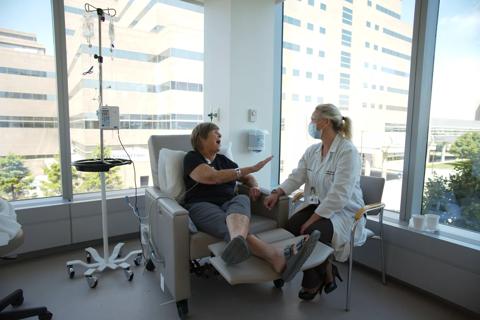Laying the groundwork, from culture to infrastructure

By Kelly Hancock, MSN, RN, NE-BC
Cleveland Clinic is a non-profit academic medical center. Advertising on our site helps support our mission. We do not endorse non-Cleveland Clinic products or services. Policy
With nearly 11,000 nurses working in inpatient, outpatient, rehabilitation and home care fields throughout Cleveland Clinic’s main campus, eight regional hospitals, 18 family health centers and Florida and Abu Dhabi locations – nursing is, without a doubt, the largest Cleveland Clinic caregiver group.
Nurses have been and always will be vital to the organization’s success – from its inception as one hospital to its transformation into an international health system. No matter where one goes within Cleveland Clinic, nursing has a presence. However, today, nursing at Cleveland Clinic has a very different structural foundation than it did a little less than a decade ago.
In 2007, Cleveland Clinic adopted the institute care model in an effort to improve collaboration, increase quality and efficiency and reduce costs. As opposed to the traditional hospital structure where a department of medicine supervises specialties and a department of surgery oversees general surgery along with other specialty procedures, the new model created institutes. With the institute model, multidisciplinary teams are treating all conditions affecting a particular organ system.
This was really the starting point in Cleveland Clinic Nursing’s journey to become a structured, unified organizational component of the health system. Nursing officially became one of the 27 institutes – to be known moving forward as The Stanley Shalom Zielony Institute for Nursing Excellence – and not long after, the role of the executive chief nursing officer (ECNO) was created (nursing throughout the system now reported to this person). The infrastructure was built and the leadership team established, and the foundational strategy was set in motion.
For the past eight years, we’ve been building and refining our structure. Our team has realized several notable lessons as we’ve evolved and found the following to be some of the most important steps nurse leaders can take to ensure nursing is successfully structured within a health system.
Lesson 1: Take the temperature of your current health system landscape.
Before a leadership team is created, before offices or departments are formed, before anything really, you must first assess the current landscape of your health system. Every system is different and the findings of this first step will vary greatly from one system to the next, but evaluating the landscape as a whole, of nursing within your system, and everything related to nursing, is imperative. To effectively structure nursing as an integrated component of your system, you need to know what the current barriers and challenges are so you can deal with them head on.
This process includes several components. The first is a culture assessment. Is the culture positive or negative? What are the strengths and weaknesses of your system’s current culture? What is the culture centered on? (i.e., patient care and safety) Do employees and caregivers feel engaged or disengaged? How does culture vary from one location or campus to the next? Does your health system operate as one? Do outside healthcare professionals view your health system as a place they would want to work? Knowing and understanding your culture is a good reflection of the beliefs, values, attitudes and priorities of the staff – including nurses – and certainly influences performance.
Employee perception is the next assessment you will want to make. What are the daily expectations of caregivers and do they think these expectations are right or fair? Do multidisciplinary teams work well together? Where do employees think the health system falls short or excels? Do nurses feel as though they have an active voice or role? How do nurses view the health system and how do other caregiver groups view nurses? Are employees, nurses specifically, happy in their place of work? Do they promote positivity about the organization within and outside of its walls?
Employee engagement surveys from organizations such as PressGaney or Gallup can prove extremely useful when seeking answers to these culture- and employee-related questions. However, it is also recommended that you conduct focus groups and interviews throughout your system and consider other internal measurement tools available to you to gauge culture and perception.
The third component in taking the temperature of your current landscape includes considering how, and at what pace, your system operates. How is your system structured and how will nursing align with that structure? How are teams/departments/offices organized and held accountable? How is success measured and what reporting methodology is used? What are the primary goals and objectives of your system for the short- and long-term future and how does nursing impact these? How will you ensure nursing is present at the decision-making table and represented on the system leadership team?
Many of these answers can be found through discussions with your system, hospital and other leadership teams. As the systemwide nursing leader, the ECNO or Chief Nursing Executive (CNE) should be a prominent leadership team member. Not only does the ECNO direct the delivery of nursing care, professional practice, development, education, information technology and more, he or she should be fully active in decision-making structures and processes, functioning at the senior leadership level and having a role within the system’s governing body, senior leadership, medical staff and management teams.
Lesson 2: Align infrastructure with operations and designate accountable leaders.
When structuring nursing within a health system, infrastructure and leadership go hand in hand. As you consider the offices or departments that will comprise your systemwide nursing organization, you also need to ensure you have trusted, accountable leaders to drive each. Your leadership team should consist of those who are known change agents and who exert character traits that empower others to collectively and collaboratively achieve your organizational and operational goals. You want your leadership team members to have a shared vision, individual competence, effective communication and support for one another, as well as mutual trust.
Your team should include system leaders (associate chief nursing officers, ACNOs) and local leaders (chief nursing officers, CNOs) and should also have several additional leadership layers built in, covering strategic planning through tactical execution. For example, the first layer in Cleveland Clinic Nursing’s structure is the strategic, steering and execution team, which consists of the ECNO, ACNOs, CNOs and other key leaders from partner areas, such as finance, human resources, marketing and communications. This team meets at least once a month and various groups within this team meet more frequently, such as the ECNO and ACNOs, or all of the CNOs. This first layer is the core group that will drive strategic direction.
The next layer is the decision-making team. This is the layer that houses your systemwide councils and committees – those organized groups that will act as the authoritative body for the core functions of nursing, such as communication; leadership and development; nursing products, solutions and technologies; research and innovation; nursing practice and patient care; and, nursing quality and process improvement.
The final two layers include affinity groups and operational teams. Affinity groups are those teams that drive work and collaboration for specialty nursing areas or geographic-specific nursing. Operational teams help lead tactical execution of a wide variety of established initiatives.
Depending on your operational goals, your systemwide nursing offices or departments will vary, but per the model used at Cleveland Clinic, the following operational areas are considered a priority and are under the direction of the systemwide nurse leader:
Lesson 3: Include all appropriate audiences in the integration process.
Just as important as taking the temperature of your current system landscape is making sure to include all target audiences in the integration process. Most importantly, this should include nurses, physicians and patients. Open, transparent two-way communication that provides the opportunity for input, questions and feedback should be a top priority. Adjusting from a silo-style nursing structure to a unified, systemwide structure will inevitably bring change, standardization likely being one of the most notable; and as reported by Talent Management in 2013, according to a Harvard Business Review blog, “people don’t resist change, they resist being changed.”
So, for effective integration, you need to make sure to manage the change. Nurse leaders should provide regular and often updates and report data and information to health system, physician and hospital leadership teams as well as caregivers. Nursing should have a recurring slot in any physician or employee newsletters or systemwide communication elements to offer insight and information about the integration of nursing. You want nursing to be viewed as a partner, especially with the physician audience.
Additionally, systemwide nursing-specific communication elements should be created – from a nursing-focused Intranet page that highlights nursing news, announcements and updates, to nursing e-newsletters, and important video and e-communication messages from the ECNO and other members of the leadership team. Throughout the transition, nurses should feel as though they have a voice in the positive direction the organization is taking. There should be a number of channels by which nurses can submit feedback, thoughts and opinions. Surveys and polls are a great way to begin getting nurses engaged, and offering special gifts for participation in communication initiatives always delivers added incentive for engagement.
It is also imperative that nurse leaders conduct leadership rounding throughout the health system to stay in front of staff nurses, patient care nursing assistants, assistant nurse managers, nurse managers, nurse directors and other members of the nursing caregiver team. This also gives leaders the opportunity to interact with patients and gauge patient experience and nurse satisfaction. Patients receive many benefits from integrating nursing within a health system, including added care resources, but care must remain high quality, safe and personalized so communication with the patient and patient’s family is pivotal. Effective communication will foster patient safety and quality of care, treatment and services.
Look for article two of this two-part series following the Cleveland Clinic Nursing Annual Nursing Leadership Summit, which will be held in late July. Part two will highlight lessons four and five, discussing process and accountability measures and strategic planning and progress evaluation.
Kelly Hancock is the Executive Chief Nursing Officer of the Cleveland Clinic Health System, and Chief Nursing Officer of Cleveland Clinic Main Campus.

Amanda Clark uses leadership skills to improve local healthcare access, mentor colleagues

Caregiver thrives despite the challenge of profound hearing loss

Mercy Hospital welcomes new chief nurse

New Lutheran Hospital CNO values quality and evidence

Nurse practitioner is a big believer in patient-caregiver collaboration

Leadership sectors include APRN and nursing quality

Fast-paced nursing environment full of reward

Experienced nurse leader Shannon Pengel appointed